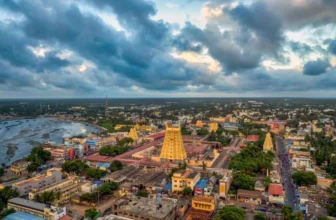In Indian mythology, Lord Hanuman is a figure of immense devotion, strength, and loyalty. His pivotal role in the Ramayana, particularly the episode where he burns down Lanka, is often a subject of discussion. While this act is celebrated as a victory of righteousness, it also highlights a profound truth about human nature and societal tendencies. The statement, “People blame Hanuman for burning Lanka, but no one questions who gave him the fire,” offers a philosophical lens to examine societal double standards and the human propensity for misplaced judgment.
—
The Context of the Story
The burning of Lanka is a significant episode in the Ramayana. After discovering Sita in Ravana’s Ashoka Vatika, Hanuman allows himself to be captured to deliver Lord Rama’s message to Ravana. As a punishment, Ravana orders Hanuman’s tail to be set ablaze. However, Hanuman, blessed by divine powers, uses this fire as a weapon to burn down Lanka, symbolizing the destruction of evil.
While Hanuman’s act was driven by a higher purpose—to demonstrate the consequences of adharma (unrighteousness)—the metaphorical interpretation of the incident raises important questions. Who is truly responsible for the destruction of Lanka? Hanuman, who used the fire, or Ravana, who ordered the fire to be lit? This question serves as a reflection of how society often places blame without addressing the root cause.
—
The Nature of Society: Quick to Judge, Slow to Reflect
This story mirrors the workings of modern society. It is common for individuals to blame those who act, without considering the circumstances or provocations that led to their actions. Hanuman is criticized for burning Lanka, but few pause to question Ravana’s arrogance, ego, and the series of choices that culminated in Lanka’s destruction. This tendency to focus on the immediate consequence rather than the root cause is a reflection of society’s double standards.
1. Blame Shifting:
Society has a tendency to shift blame onto the visible actor rather than questioning the instigator. In Hanuman’s case, the fire was a result of Ravana’s orders. Yet, it is Hanuman who is held accountable for the destruction. This is akin to how, in real life, whistleblowers, reformers, or revolutionaries are often vilified for their actions, while the system or individuals who created the problem remain unchallenged.
2. Judging Without Context:
People often judge actions without understanding the context or intent behind them. Hanuman’s act was not born out of malice but as a response to Ravana’s tyranny. Similarly, in society, actions driven by justice or necessity are sometimes misunderstood or misinterpreted, leading to unwarranted criticism.
3. Fear of Confronting the Root Cause:
Addressing the root cause often requires courage, effort, and introspection. It is easier to blame the person who acts than to confront the more complex systems or individuals who are truly responsible. Ravana’s actions—his kidnapping of Sita and his refusal to return her despite repeated warnings—were the true cause of Lanka’s destruction. Yet, it is Hanuman who bears the blame in this narrative.
—
Lessons for Modern Society
The phrase “చూసి రమ్మంటే కాల్చి వచ్చాడు అని హనుమంతుడిని నిందిస్తారు కానీ కాల్చడానికి నిప్పు ఎవరిచ్చారు అని ఎవరూ ఆలోచించరు” (People blame Hanuman for burning Lanka but do not think about who gave him the fire) offers profound lessons:
1. Think Before You Judge:
Before placing blame, it is essential to analyze the entire situation. What were the triggers? Who set the events in motion? Context matters, and rushing to judgment without it can lead to injustice.
2. Address the Root Cause:
Instead of focusing solely on the consequences, society must learn to address the underlying issues. Whether it’s in personal relationships, workplaces, or broader societal challenges, identifying and solving the root cause is the only way to prevent recurrence.
3. Empathy for the Doer:
Those who take action often do so under challenging circumstances. Whether it is Hanuman burning Lanka to uphold dharma or a modern-day activist fighting against corruption, their actions are often a response to a greater problem. Understanding their perspective is key to fair judgment.
—
The Broader Message: Society’s Double Standards
This story also highlights the hypocrisy ingrained in society. People celebrate Hanuman as a hero and devotee of Lord Rama, yet some narratives blame him for the destruction of Lanka. This duality reflects the tendency of society to both praise and criticize the same individual based on convenience.
Such double standards are not limited to mythology. In contemporary times, reformers, innovators, and change-makers often face similar criticism. While their actions bring about positive change, they are frequently blamed for the upheaval their actions cause, rather than appreciated for addressing the deeper issues.
—
Conclusion
The episode of Hanuman burning Lanka is not just a tale of devotion and righteousness but also a mirror to societal behavior. It teaches us to look beyond the surface, question the root cause, and refrain from misplaced judgment. Society must learn to differentiate between the doer and the provocateur, between the consequence and the cause. Only then can justice, fairness, and true understanding prevail.
Just as Hanuman’s act ultimately served the greater good, so too can our actions—when rooted in righteousness—lead to transformative change. However, as a society, we must evolve to recognize and address the real causes of problems, rather than merely assigning blame to those who act.











